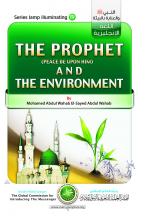Abu Nayij al-'Irbad Ibn Sariah (que Allah esté complacido con él) dijo: Cierta vez nos exhortó el Mensajero de Alá (la paz sea con él) de forma tal que los corazones temblaron y los ojos lloraron. Dijimos ¡Oh Mensajero de Alá! parece una exhortación de despedida, así que aconséjanos. Dijo: “Os aconsejo temer a Alá, escuchar y obedecer aunque os gobierne un esclavo, ya que quien viva de vosotros ha de ver muchas discrepancias. Así pues que, apegaos mi Sunnah y la Sunnah de los califas rectos y guiados, aferraos a ellas con los dientes, y evitad las innovaciones, porque toda innovación es un desvío, y todo desvío tiene por destino el fuego”. (Transmitido por Abu Dawd y Tirmidhi, quien dijo: Es un hadiz Hasan-Sahih (aceptable y auténtico)
El profeta de la misericordia Site
Liga del Mundo Islámico - Organismo Mundial para la Presentación del Mensajero
By Abul hasan ‘Ali Nadwi
Arabia had been the birth place of several prophets of God in the bygone times. The Quran says:
"And make mention (O Muhammad) of the brother of Aad when he warned his folk among the wind curved sandhills—and verily warners came and went before and after him—saying: Serve none but Allah. Lo! I fear for you the doom of a tremendous Day . (Qur’an 46:21)
Prophet Hud[1] was sent to the Aad; a people, according to historians, belonging to the Arab Baidah who lived in a tract of white or reddish sand blown into hill banks or dunes and covering a vast area to the south west of al Rate al Khali (the vacant quarter) near Hadramaut. This region has no habitation and is void of the breath of life, but it was a verdant land in the ancient times, with flourishing towns inhabited by a people of gigantic strength and stature. The whole area was consumed by a fearful and roaring wind which covered it with sand dunes.[2]
The Quranic verse quoted above shows that the Prophet Hud was not the only messenger of God sent to the ancient Arabs of this area as many more warners came and went before him.
Salih[3] was another Arabian Prophet sent to the people called Thamud who lived in al Hijr situated between Tabuk and Hijaz. Prophet Ismail was brought up in Mecca, and he died in the same city. If we extend the frontiers of the Arabian peninsula northwards to include Midian on the borders of Syria, Prophet Shuyeb (Indentified with Jethro) would also be reckoned as an Arabian prophet. The historian Abul Fida says that Midianites were Arabs, living in Midian near Maan, which is adjacent to the Sea of Lut (Dead Sea) in Syria on the frontier of Hijaz. The Midianites flourished after the downfall of the people of Lut.
Ancient Arabia had been the cradle of many a civilised and flourishing people to whom God had sent His apostles. But all of them were either destroyed because of their evil ways or became strangers in their own homeland, or were forced to seek new homes. The prophets of God born in the lands far away had sometimes to seek refuge in Arabia from the despotic kings of their lands. Ibrahim (Abraham) had migrated to Mecca and Moses had to flee to Midian. Followers of other religions, too, had to seek shelter in Arabia. The Jews, when persecuted by the Romans, had settled in Yemen and Yathrib while several Christian sects harassed by the Byzantine Emperors had migrated to Najran.[4]
------------------------------
[1] Recognized by some as Heber of the Bible (Judges iv-l).
[2] For details see the Chapter “The Reality” of the Qur’an.
[3] Identified by some as Salah of Genesis xi-13.
[4] For further details see Vol. I of Kathim-un-Nabiyin by Shekh Muhammad Abu Zuhra.
******




